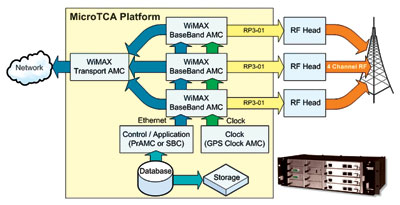|
On July 6, 2006, the MicroTCATM PICMG® Specification MTCA.0 R1.0 was adopted. Over the last year many of the architecture building blocks have been released and the entire MicroTCA ecosystem is taking shape. The purpose of the MicroTCA specification is to allow solution providers a lower cost alternative to ATCA platforms for non-core applications.
The wireless space is in perfect position to reap the benefits of the MicroTCA architecture; while conversely, MicroTCA needs the type of production velocity that this vertical offers.
Wireless technologies that can leverage MicroTCA
Considering the four distinct wireless technologies of CDMA, GSM/UMTS, WiMAX, and UMA, it seems that the IEEE 802.16- 2005 Mobile WiMAX (Worldwide Interoperability for Microwave Access) is positioned the best to leverage the MicroTCA architecture. The WiMAX network promises meaningful increases in bandwidth at a lower total cost than what is currently expected in other networks and will open the door for new application markets to wireless service providers. For example, Sprint (S) plans to use Mobile WiMAX to enable device-dependent applications that connect to phones, Personal Digital Assistants (PDAs), and laptops. Both Nokia (NOK) and Motorola (MOT) expect to start selling mobile devices using WiMAX Internet technology in early 2008.
Figure 1 represents a 3-sector WiMAX base station configured in a single 3U MicroTCA platform. In this example, we have three baseband and one transport double wide AMC modules configured into a ten slot enclosure. The system also contains two Micro Controller Hubs (MCH) for switch and clocking, redundant power supplies, one processor AMC, and a storage AMC.
With respect to the WiMAX network, the two important advantages that MicroTCA offers are lower system cost and AMC flexibility. Each of the AMC slots will typically require less than 80 Watts which puts less power and cooling design burdens on the platform, thus resulting in lower production costs. Additionally, the AMC base specification allows board designers a consistent design guide to work from ensuring interoperability.
Challenges
The introduction of MicroTCA into the wireless network will not come without challenges. We can categorize these challenges into three main areas:
- Payload slots per system
- Clocking synchronization
- Backplane topology definition
First let's look at the amount of payload slots required. According to Laurie Burger, Product Management Director Pentair/Schroff … "The biggest issue so far is the battle over the number of payload slots in the smaller form factor MicroTCA systems. By the time you add in MCHs, power supplies, and then processor boards - there is a major issue over having enough space for the payload AMCs. Right now the MCHs and the power supplies are consuming more space than anticipated."
Another challenge has come in the ambiguous clocking definitions in the MicroTCA specification itself. The WiMAX blades require two clock sources, usually derived from GPS signals to synchronize. The current specification does not allow for two different clock sources to work with redundancy. This gap requires designers to add cost to the MCH and back plane to ensure proper clocking for the modules.
Lastly, the AMC port/lane mappings are well defined in the PICMG® specifications; however, the back plane topology must be designed in such a way that they will accommodate the AMC mappings. The inherent small form factor coupled with these customized back planes will drive up the cost on the entire solution.
Final Score
In the end, MicroTCA will be a winner in the wireless network, if the production take rate is sufficient to overcome some of the architectural challenges.
Jeff Hudgins is VP of Engineering at Alliance Systems. (news - alert) For more information, visit the company online at http://www.alliancesystems.com.
|

